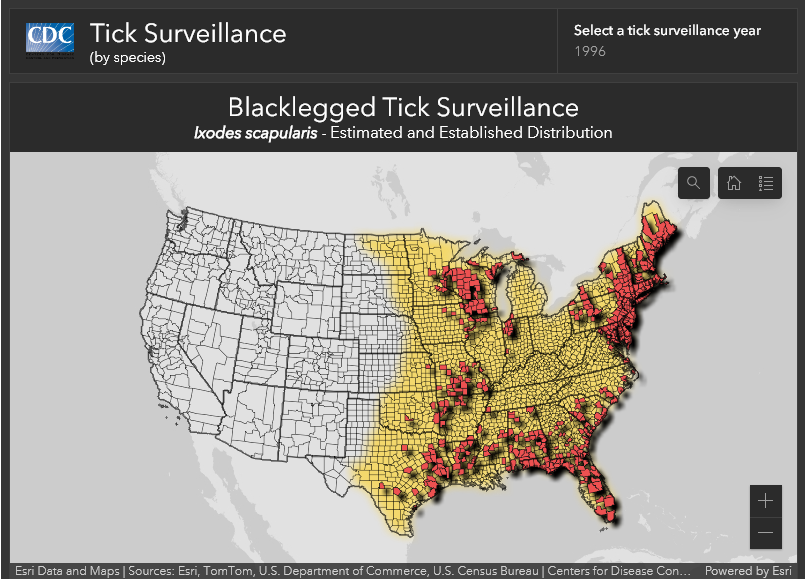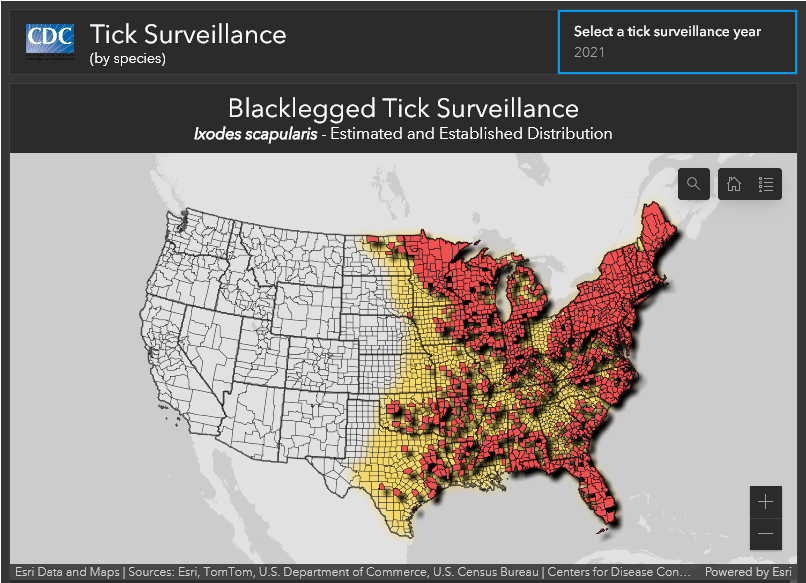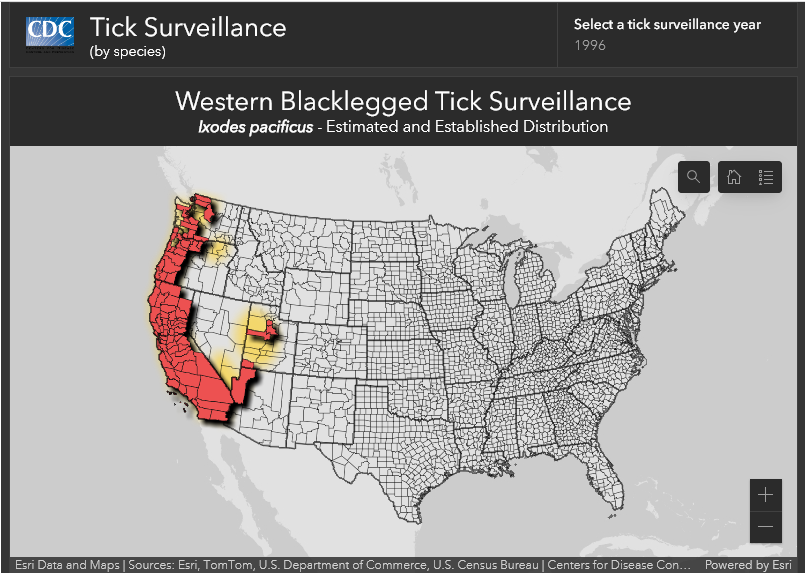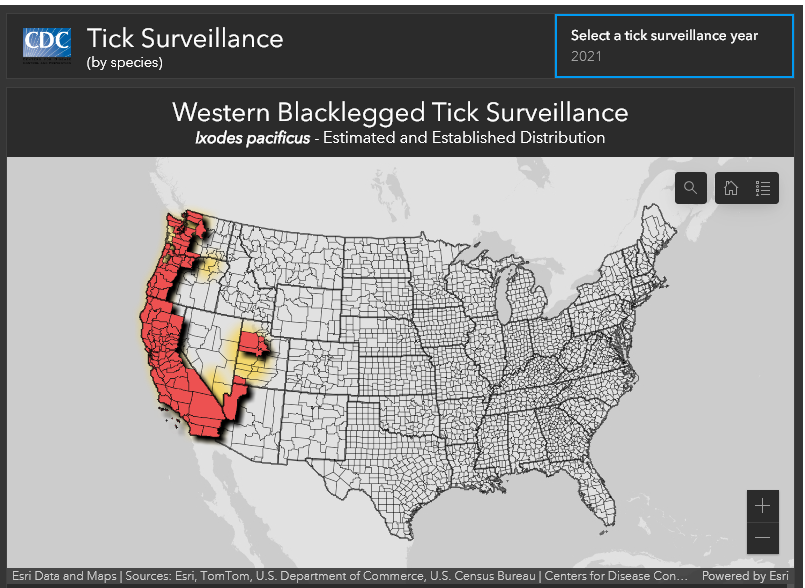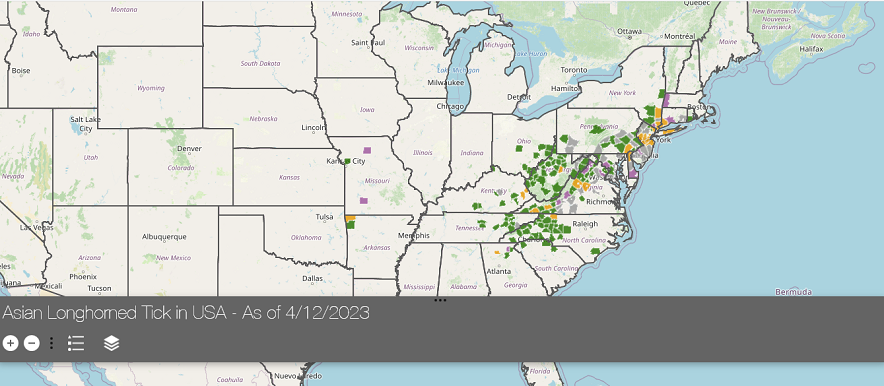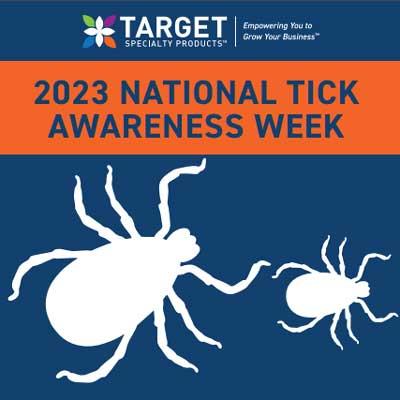
In many areas of North America, May brings warmer weather, backyard barbecues, and more time outside – all of which put humans, our pets, and livestock at increased risk of tick exposure.
Over the last three decades, scientists have been tracking the movement of ticks and tickborne diseases, such as Lyme disease, babesiosis, Powassan virus, and more. There is significant cause for concern. Many native tick species are expanding their geographical range, moving into new areas where they haven't been seen before. We have also seen non-native species introduced, posing new threats.
Pest management providers have a responsibility to educate customers on the dangers ticks pose. To help you do that, our experts look at three lesser-known tick species that are becoming increasing risks in North America: Asian longhorned ticks, lone star ticks, and Gulf Coast ticks.
WHY ARE TICKS ON THE RISE?
In 2018, a U.S. Centers for Disease Control and Prevention (CDC) report1 reviewed vectorborne disease cases in the U.S. from 2004 - 2016, specifically those spread by mosquitoes and ticks. The authors found that of 650,000 cases, three-quarters were associated with ticks, making for a dire warning about the increasing danger.
- "Reported cases of tickborne disease have doubled in the 13-year analysis period, with Lyme disease accounting for 82% of cumulative reported tickborne disease. The combined incidence of reported anaplasmosis and ehrlichiosis, which are tickborne bacterial diseases, rose almost every year, as did spotted fever; babesiosis, a tickborne parasitic infection that has been notifiable since 2011, also contributed to the rise." – Vital Signs: Trends in Reported Vectorborne Disease Cases — United States and Territories, 2004–2016, U.S. Centers for Disease Control and Prevention
The reasons behind this increase are complex, however, there are a few key factors fueling tick expansions.
- Land development
Humans are developing land at a record pace, pushing our living areas into natural habitats of animals that ticks feed on, such as squirrels, rodents, deer, coyotes, wild turkeys, frogs, and snakes. According to one estimate by The Washington Post based on U.S. Geological Survey data2, between 2001 and 2019, the U.S. developed over 14,000 new square miles of land – an area nearly twice the size of New Jersey. - As humans move into new areas, we are more likely to come into contact with these animals and the ticks they carry, whether on a hiking trail or in our backyards.
- Reforestation
Climate awareness has also led to our efforts to restore natural habitats. Reforestation is reintroducing biodiversity to areas where it had disappeared or may not have been present previously. When animals return to these re-forested areas, ticks move with them, slowly increasing the range of species that may not have been present previously. - Climate change
Shifting weather patterns are contributing to growing tick populations and tick migration. With some areas of North America getting warmer earlier in the year and staying warmer later, temperature-sensitive ticks may more easily acclimate in new areas. Warmer temperatures also affect the tick life cycle. - Ticks are not born carrying pathogens. They acquire them through feeding on infected hosts. Tick larvae emerging in mid to late summer look for hosts to feed on; however, this larval feeding period is short and limits the chances larvae contract pathogens. Larvae become inactive in late fall and winter before emerging as nymphs in the spring, when they actively feed and are likely to contract pathogens.
- Taal Levi, associate professor in the College of Agricultural Sciences at Oregon State University, explains how this increases tickborne disease risk in native blacklegged tick species
"The Lyme disease pathogen is long-lived - it will remain in the host. So an increasing gap between the nymphs feeding in the spring and the next cohort of larvae feeding in late summer will give the nymphs more time to infect the hosts with bacterium that can then be passed to the next generation of tick larvae."3
– "Climate change may affect tick life cycles, Lyme disease,"
Oregon State University
- Increasing small animal host populations
Ticks feed on a variety of animals in the wild, including rodents, such as mice, rats, squirrels, chipmunks, and gophers. There is increasing evidence that some rodent populations are growing for many of the same reasons that tick risks are increasing. Peridomestic rodents, such as mice and rats, live among humans and even benefit from our activity. As these animals infest structures, they bring the potential for tick introduction into new areas. - Livestock roaming and transport
The practice of allowing livestock to roam open rangeland, particularly in the Western U.S., may help to spread ticks as land is developed and livestock roaming is forced to new areas. Secondary spread may also occur as livestock are transported, potentially introducing any ticks they carry to new areas.
THE EXPANSIVENESS OF BLACKLEGGED TICK SPECIES
The blacklegged tick, often called a deer tick (Ixodes scapularis) and the Western blacklegged tick (Ixodes pacificus) are the primary vectors of Lyme disease, which is by far the most reported tickborne disease in the United States. The CDC’s range surveillance maps below show the expanding range of these species by illustrating counties where these tick species have been established (red) and where populations are estimated (yellow). For more information, click on a map to visit the CDC's surveillance website.4, 5
3 LESSER-KNOWN TICK SPECIES TO WATCH
While blacklegged tick species remain the focus of many public health professionals, three lesser-known tick species are on the move: the Asian longhorned tick, the lone star tick, and the Gulf Coast tick. These three species pose significant health risks to humans, domesticated pets, such as dogs and cats, and livestock animals. If your pest management company operates in these areas, being able to identify these ticks and understanding the dangers they pose will help you educate both your residential and commercial customers.
Asian longhorned tick
Native to East Asia, the Asian longhorned tick (Haemaphysalis longicornis) was first identified in the United States in 2017, found on sheep in New Jersey. This tick is dangerous to livestock, especially cattle, but also sheep and goats. Large numbers will attack a single host, which can weaken animals, affect milk production, and lead to death.6 Asian longhorned ticks can cause bovine theileriosis, a livestock disease with a high fatality rate.
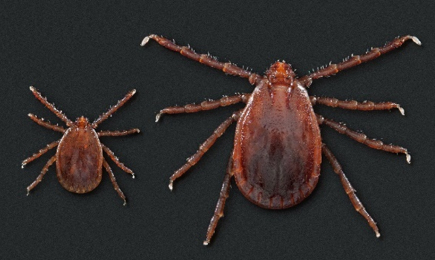 |
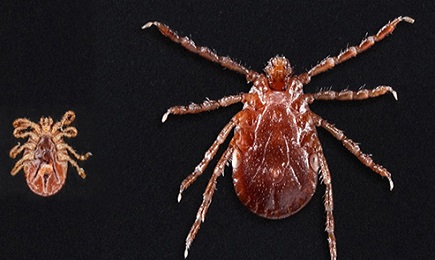 |
| Top view of a nymph (left) and an adult female (right) Asian long-horned tick | The underside view of a nymph (left) and an adult female (right) Asian long-horned tick |
| Source: U.S. Centers for Disease Control and Prevention | |
|---|---|
Other animals, including humans, can be bitten by the Asian longhorn tick, although the CDC notes that when compared with other biting ticks, this tick appears to be "less attracted to human skin."7 In the wild, white-tailed deer are a primary host, while domestic animals, including dogs and cats, can also serve as a host.8 Asian longhorn ticks can spread babesiosis, a disease which has recently been in the news for increasing cases in the Northeast.
Asian longhorn ticks do not need a mate to reproduce, a process known as parthenogenesis. A single female could populate an entire localized area, producing as many as 2,000 eggs.
As of August 22, 2022 the CDC reports that the Asian longhorned tick has been identified in 18 states. Because of its impact on livestock, the U.S. Department of Agriculture is conducting surveillance. Click on the map below to see the most recent activity.9
Reporting of this invasive species is critically important. If you suspect you have found an Asian longhorned tick, the CDC recommends the following:
- Remove ticks from humans or animals as quickly as possible;
- Try to save a sample for identification; put it in a container with rubbing alcohol;
- Report any suspected Asian longhorn ticks to your state agriculture department or local extension office;
- If the ticks were found on livestock, contact your veterinarian for treatment options.
Lone star tick
The lone star tick (Amblyomma americanum), so named because of the identifying single white star-like feature on the back of female ticks, is an aggressive biting tick species native to the South, Southeastern, and Eastern United States. This tick has the capability to transmit a number of dangerous pathogens, which can cause a range of diseases and conditions in humans,10 including:
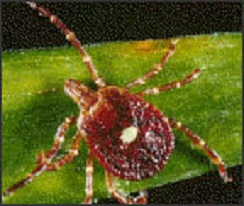 |
|
| An adult female Lone star tick | |
| Source: U.S. Centers for Disease Control and Prevention | |
|---|---|
While many of these diseases can be life-threatening if left untreated, there is one unusual condition worthy of note. Although scientists do not fully understand why, experts believe that being bitten by the lone star tick can cause some people to develop Alpha-gal syndrome, an allergy to red meat and other products from mammals, such as dairy products.11 This allergy can develop rapidly and without warning, creating life-threatening anaphylactic reactions. There is no cure for Alpha-gal syndrome other than avoiding red meat or products that trigger it.
Over the last eight years, the lone star tick has expanded its range, as illustrated by the CDC surveillance maps below, and established populations are becoming significantly more dense. This species' range is moving west and north.
| 2015 | 2022 |
|---|---|
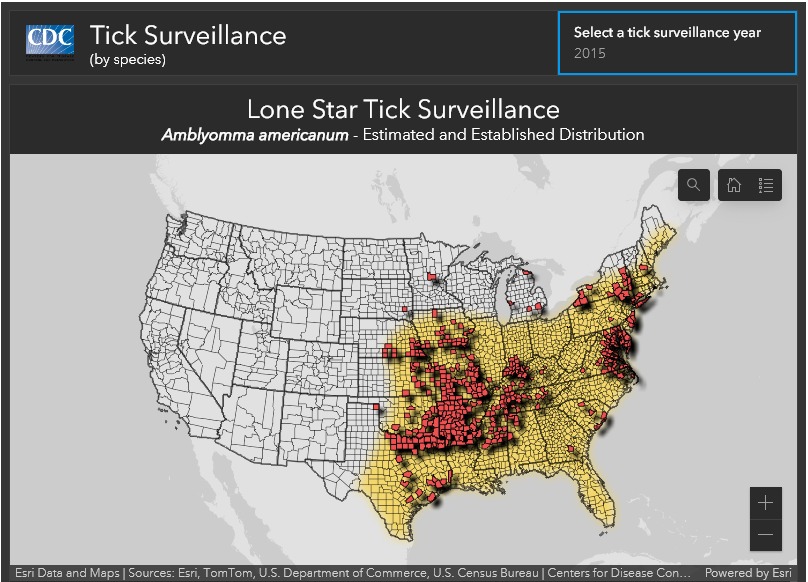 |
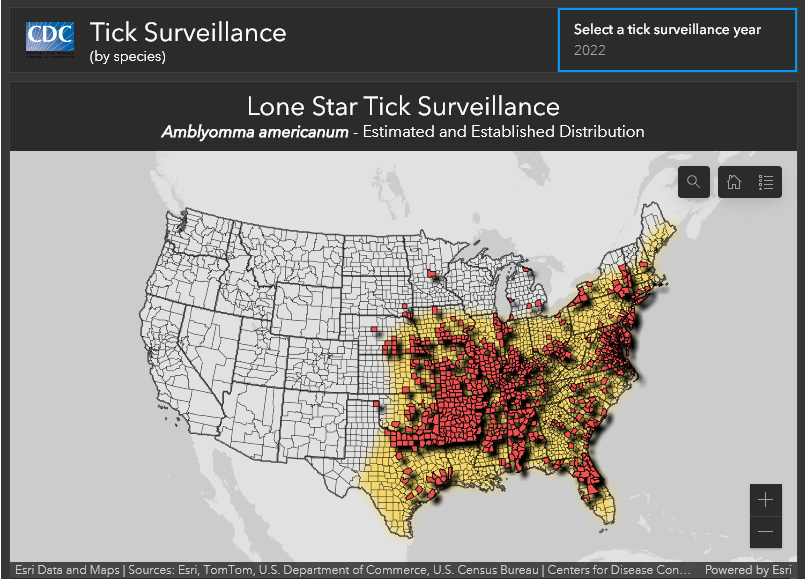 |
| Lone star tick (Amblyomma americanum) | Lone star tick (Amblyomma americanum) |
| Source: U.S. Centers for Disease Control and Prevention | |
Gulf Coast tick
The Gulf Coast tick (Amblyomma maculatum) is native to the states that border the Gulf of Mexico, including Alabama, Florida, Louisiana, Mississippi, and Texas. This aggressive biting species is concerning because of its ability to spread disease to humans and animals.
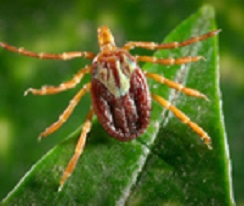 |
|
| An adult Gulf Coast tick | |
| Source: U.S. Centers for Disease Control and Prevention | |
|---|---|
Among humans, Gulf Coast ticks can transmit the pathogen responsible for Rickettsiosis (a form of Spotted Fever), and their bite can cause tick paralysis. As the University of Florida notes, until 2002, Rickettsia rickettsii, the causative agent of Rocky Mountain spotted fever, was the only known tickborne spotted fever in the U.S. However, in 2002, a case of spotted fever in Virginia stemming from the causative agent Rickettsia parkeri, was found to have been caused by the bite of the Gulf Coast tick and "is now recognized as a human pathogen of increasing public health concern in the southeastern United States."12
In domesticated animals, Gulf Coast ticks can cause heptazoonosis in dogs, a lifelong condition that can be fatal if left untreated. The disease is not acquired through a tick bite, but when dogs consume the tick while grooming. There have also been documented cases of these ticks causing tick paralysis in dogs.
In recent years, the Gulf Coast tick has continued to move north up the East Coast and into the interior of the United States. Although the CDC map below does not indicate their presence in these areas, northern and interior states including Pennsylvania and Indiana offer warnings about this tick via state agency websites; Indiana reports identifying a number of ticks infected with Rickettsia parkeri. Unlike other disease-spreading ticks, this tick is not yet under surveillance by the CDC, USDA, or other government agency.
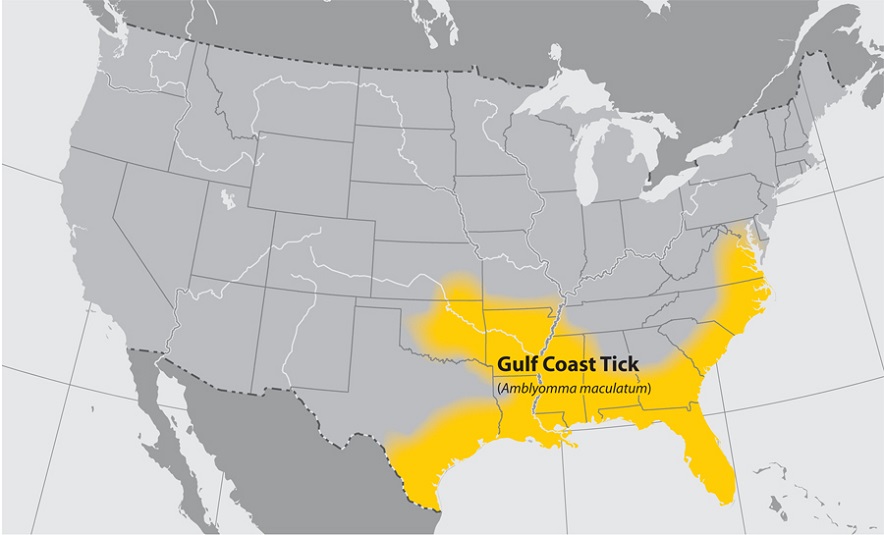
| Source: U.S. Centers for Disease Control and Prevention |
|---|
PROTECTING PEOPLE AND ANIMALS FROM TICKS
With tick dangers on the rise, pest management companies play a critical role in protecting public health. It's important to know which tick species are active in your area so that you can properly identify them.
Don't miss an opportunity to share these general tick prevention tips with your customers. Remember, they apply for you on the job, too!
- When you are outside in areas where ticks are known to be active, use a U.S. Environmental Protection Agency-approved insect repellent, wear long pants and long-sleeved shirts, and consider tucking your pants into your socks.
- After being outside, conduct a thorough tick-check, including your skin and clothing.
- Check pets and livestock regularly for ticks.
- Know how to properly remove a tick.
- Speak to a veterinarian about proactive tick protection for pets.
- Have yards or grounds treated with a preventative application to deter ticks.
- Keep grasses and vegetation trimmed in outdoor seating, leisure, or play areas.
- Remove lawn and leaf debris; this can serve as harborage for ticks.
- Businesses should consider posting warning signs in areas of their property where there is tick activity.
- Report unusual tick activity to your local agricultural extension office or state department of agriculture.
If you suspect that you, your pet, or livestock have been bitten, attempt to save any portion of the tick that you can for identification. Submerse the tick in a small container filled with rubbing alcohol. Monitor for signs of illness over several days and contact your doctor or veterinarian immediately if you notice any of these symptoms or do not feel well.
| SYMPTOMS OF TICKBORNE ILLNESS | |
|---|---|
| Humans | Animals |
| Fever | Lethargy (more than usual) |
| Chills | Joint pain, limping, or lameness |
| Swelling at the site of the bite or around joints | Swollen lymph nodes |
| Aches, pains, and stiffness | Decreased appetite |
| Rashes, spots, or a bullseye pattern on skin | Fever |
| Any wounds or ulcers near the site of the bite | Open wounds |
With your expertise and a focus on education, your customers can stay protected from ticks all season long. Don't forget, if you have tick questions, use our Ask the Experts feature to find answers.
Sources:
- 1 Rosenberg R, Lindsey NP, Fischer M, et al. Vital Signs: Trends in Reported Vectorborne Disease Cases — United States and Territories, 2004–2016. MMWR Morbidity and Mortality Weekly Report, May 18, 2018;67:496–501. Accessed online April 18, 2023.
- 2 Eng, J and Levitt, Z. "America’s developed areas are growing: ‘Way off into the horizon’." The Washington Post, August 11, 2021. Accessed online April 26, 2023.
- 3 Levi, Taal. "Climate change may affect tick life cycles, Lyme disease." Oregon State University, February 17, 2015. Accessed online April 26, 2023.
- 4 Blacklegged tick (Ixodes scapularis) surveillance. U.S. Centers for Disease Control and Prevention. Last reviewed December 2, 2022. Accessed online April 26, 2023.
- 5 Western blacklegged tick (Ixodes pacificus) surveillance. U.S. Centers for Disease Control and Prevention. Last reviewed December 2, 2022. Accessed online April 26, 2023.
- 6 Asian Longhorned Tick. Cornell College of Agriculture and Life Sciences. Accessed online April 18, 2023.
- 7 What you need to know about Asian longhorned ticks – A new tick in the United States. U.S. Centers for Disease Control and Prevention. Last reviewed January 26, 2023. Accessed online April 18, 2023.
- 8 Featured Creatures: Asian longhorn tick. University of Florida Institute of Food and Agricultural Science, Entomology and Nematology. Accessed online April 26, 2023.
- 9 The Asian Longhorned Tick: What You Need to Know and What You Can Do. United States Department of Agriculture Animal and Plant Health and Inspection Service (APHIS). Accessed online April 26, 2023.
- 10 Regions where ticks live. U.S. Centers for Disease Control and Prevention. Last reviewed December 5, 2022. Accessed online April 26, 2023.
- 11 Alpha-gal syndrome. The Mayo Clinic. Accessed online April 26, 2023.
- 12 Featured Creatures: Common Name - Gulf Coast Tick. University of Florida Institute of Food and Agricultural Science, Entomology and Nematology.
- Other sources:
Diseases Transmitted by Ticks. U.S. Centers for Disease Control and Prevention. Accessed online April 18, 2023. - Tick Surveillance, Lonestar Tick. U.S. Centers for Disease Control and Prevention. Accessed online April 18, 2023.
- Sonenshine, Daniel E. Range Expansion of Tick Disease Vectors in North America: Implications for Spread of Tick-Borne Disease. International Journal of Environmental and Public Health Research, 2018; 15(3), 478. Originally published March 9, 2018. Accessed online April 18, 2023.
